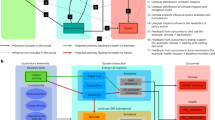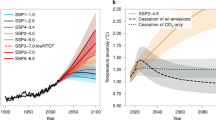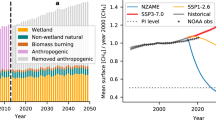Abstract
Actions to reduce greenhouse gas (GHG) emissions often reduce co-emitted air pollutants, bringing co-benefits for air quality and human health. Past studies1,2,3,4,5,6 typically evaluated near-term and local co-benefits, neglecting the long-range transport of air pollutants7,8,9, long-term demographic changes, and the influence of climate change on air quality10,11,12. Here we simulate the co-benefits of global GHG reductions on air quality and human health using a global atmospheric model and consistent future scenarios, via two mechanisms: reducing co-emitted air pollutants, and slowing climate change and its effect on air quality. We use new relationships between chronic mortality and exposure to fine particulate matter13 and ozone14, global modelling methods15 and new future scenarios16. Relative to a reference scenario, global GHG mitigation avoids 0.5±0.2, 1.3±0.5 and 2.2±0.8 million premature deaths in 2030, 2050 and 2100. Global average marginal co-benefits of avoided mortality are US$50–380 per tonne of CO2, which exceed previous estimates, exceed marginal abatement costs in 2030 and 2050, and are within the low range of costs in 2100. East Asian co-benefits are 10–70 times the marginal cost in 2030. Air quality and health co-benefits, especially as they are mainly local and near-term, provide strong additional motivation for transitioning to a low-carbon future.
This is a preview of subscription content, access via your institution
Access options
Subscribe to this journal
Receive 12 print issues and online access
$209.00 per year
only $17.42 per issue
Buy this article
- Purchase on Springer Link
- Instant access to full article PDF
Prices may be subject to local taxes which are calculated during checkout





Similar content being viewed by others
References
Working Group on Public Health and Fossil Fuel Combustion Short-term improvements in public health from global climate policies on fossil fuel combustion: An interim report. Lancet 350, 1341–1349 (1997).
Cifuentes, L., Borja-Aburto, V. H., Gouveia, N., Thurston, G. & Davis, D. L. Climate change: Hidden health benefits of greenhouse gas mitigation. Science 293, 1257–1259 (2001).
Barker, T. et al. in IPCC Climate Change 2007: Mitigation of Climate Change (eds Metz, B., Davidson, O. R., Bosch, P. R., Dave, R. & Meyer, L. A.) 619–690 (Cambridge Univ. Press, 2007).
Markandya, A. et al. Public health benefits of strategies to reduce greenhouse-gas emissions: Low-carbon electricity generation. Lancet 374, 2006–2015 (2009).
Nemet, G. F., Holloway, T. & Maier, P. Implications of incorporating air-quality co-benefits into climate change policymaking. Environ. Res. Lett. 5, 014007 (2010).
Bell, M. L. et al. Ancillary human health benefits of improved air quality resulting from climate change mitigation. Environ. Health 7, 41 (2008).
Task Force on Hemispheric Transport of Air Pollution Hemispheric Transport of Air Pollution 2010, Part A. Ozone and Particulate Matter (United Nations Economic Commission for Europe, 2010).
West, J. J., Fiore, A. M., Horowitz, L. W. & Mauzerall, D. L. Global health benefits of mitigating ozone pollution with methane emission controls. Proc. Natl Acad. Sci. USA 103, 3988–3993 (2006).
Anenberg, S. C. et al. Intercontinental impacts of ozone pollution on human mortality. Environ. Sci. Technol. 43, 6482–6487 (2009).
Jacob, D. J. & Winner, D. A. Effect of climate change on air quality. Atmos. Environ. 43, 51–63 (2009).
Weaver, C. P. et al. A preliminary synthesis of modeled climate change impacts on US regional ozone concentrations. Bull. Am. Meteorol. Soc. 90, 1843–1863 (2009).
Fiore, A. M. et al. Global air quality and climate. Chem. Soc. Rev. 41, 6663–6683 (2012).
Krewski, D. et al. Extended Follow-up and Spatial Analysis of the American Cancer Society Study Linking Particulate Air Pollution and Mortality (Health Effects Institute, 2009).
Jerrett, M. et al. Long-term ozone exposure and mortality. N. Engl. J. Med. 360, 1085–1095 (2009).
Anenberg, S. C., Horowitz, L. W., Tong, D. Q. & West, J. J. An estimate of the global burden of anthropogenic ozone and fine particulate matter on premature human mortality using atmospheric modeling. Environ. Health Persp. 118, 1189–1195 (2010).
Moss, R. H. et al. Representative concentration pathways: A new approach to scenario development for the IPCC fifth assessment report. Nature 463, 747–756 (2010).
Hughes, B. B. et al. Projections of global health outcomes from 2005 to 2060 using the International Futures integrated forecasting model. Bull. World Health Organ. 89, 478–486 (2011).
Thomson, A. M. et al. RCP4.5: A pathway for stabilization of radiative forcing by 2100. Climatic Change 109, 77–94 (2011).
Van Vuuren, D. et al. The representative concentration pathways: An overview. Climatic Change 109, 5–31 (2011).
Smith, S. J., West, J. J. & Kyle, P. Economically consistent long-term scenarios for air pollutant and greenhouse gas emissions. Climatic Change 108, 619–627 (2011).
Clarke, L. et al. International climate policy architectures: Overview of the EMF 22 International Scenarios. Energy Econom. 31, S64–S81 (2009).
Burtraw, D. et al. Ancillary benefits of reduced air pollution in the US from moderate greenhouse gas mitigation policies in the electricity sector. J. Environ. Econ. Manage. 45, 650–673 (2003).
Van Vuuren, D. P. et al. Exploring the ancillary benefits of the Kyoto Protocol for air pollution in Europe. Energy Policy 34, 444–460 (2006).
McCollum, D. L. et al. Climate policies can help resolve energy security and air pollution challenges. Climatic Change 119, 479–494 (2013).
Wilkinson, P. et al. Health and climate change 1: Public health benefits of strategies to reduce greenhouse-gas emissions: Household energy. Lancet 374, 1917–1929 (2009).
Pechony, O. & Shindell, D. T. Driving forces of global wildfires over the past millennium and the forthcoming century. Proc. Natl Acad. Sci. USA 107, 19167–19170 (2010).
Klimont, Z., Smith, S. J. & Cofala, J. The last decade of global anthropogenic sulfur dioxide: 2000-2011 emissions. Environ. Res. Lett. 8, 014003 (2013).
Emmons, L. K. et al. Description and evaluation of the Model for Ozone and Related chemical Tracers, version 4 (MOZART-4). Geosci. Model Develop. 3, 43–67 (2010).
Lamarque, J. F. et al. The Atmospheric Chemistry and Climate Model Intercomparison Project (ACCMIP) overview and description of models, simulations and climate diagnostics. Geosci. Model Develop. 6, 179–206 (2013).
Brauer, M. et al. Exposure assessment for estimation of the global burden of disease attributable to outdoor air pollution. Environ. Sci. Technol. 46, 652–60 (2012).
Acknowledgements
This publication was financially supported by the US Environmental Protection Agency STAR grant #834285, the Integrated Assessment Research Program in the US Department of Energy, Office of Science, the National Institute of Environmental Health Sciences grant #1 R21 ES022600-01, fellowship SFRH/BD/62759/2009 from the Portuguese Foundation for Science and Technology (to R.A.S.), and an EPA STAR Graduate Fellowship (to M.M.F.). Its contents are solely the responsibility of the grantee and do not necessarily represent the official views of the USEPA or other funding sources. USEPA and other funding sources do not endorse the purchase of any commercial products or services mentioned in the publication. NCAR is operated by the University Corporation of Atmospheric Research under sponsorship of the National Science Foundation. We thank the National Oceanographic and Atmospheric Administration for computing resources, L. Emmons for MOZART-4 guidance, and G. Characklis.
Author information
Authors and Affiliations
Contributions
J.J.W. and S.J.S. conceived of the study. J.J.W., J-F.L., Z.A. and M.M.F. prepared emissions inputs, and V.N. and L.W.H. prepared meteorological inputs. J.J.W. conducted the MOZART-4 simulations, and J.J.W., Y.Z., Z.A. and M.M.F. analysed MOZART-4 output. R.A.S., J.J.W., S.A. and Y.Z. analysed human mortality. Economic valuation was conducted by J.J.W., S.J.S. and S.A. J.J.W. wrote the paper and all co-authors commented on it.
Corresponding author
Ethics declarations
Competing interests
The authors declare no competing financial interests.
Supplementary information
Rights and permissions
About this article
Cite this article
West, J., Smith, S., Silva, R. et al. Co-benefits of mitigating global greenhouse gas emissions for future air quality and human health. Nature Clim Change 3, 885–889 (2013). https://doi.org/10.1038/nclimate2009
Received:
Accepted:
Published:
Issue Date:
DOI: https://doi.org/10.1038/nclimate2009
This article is cited by
-
The impacts of decarbonization pathways on Sustainable Development Goals in the European Union
Communications Earth & Environment (2024)
-
Managing urban development could halve nitrogen pollution in China
Nature Communications (2024)
-
Nano-spherical Fe3O4 modified NixSy@SiMPs composite materials improve photoelectrochemical performance
Journal of Materials Science: Materials in Electronics (2024)
-
Priorities for research to support local authority action on health and climate change: a study in England
BMC Public Health (2023)
-
An integrated view of correlated emissions of greenhouse gases and air pollutants in China
Carbon Balance and Management (2023)



